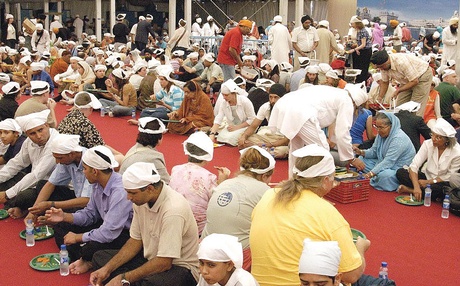 Gurdwaras across the globe have been the pivot of Punjabi confluence and a refuge away from home since times immemorial. But now they are providing succor and piping hot food to people from other religions and nationalities as well. The langar or free community kitchen run at gurdwaras was started by the first Sikh Guru, Guru Nanak Dev, and today is also acting as a lifeline for many non-Sikhs across the world at a time of global recession. According to the Sikh Federation UK, 5000 meals are now served to non-Sikhs by UK’s 250 gurdwaras every week.
Gurdwaras across the globe have been the pivot of Punjabi confluence and a refuge away from home since times immemorial. But now they are providing succor and piping hot food to people from other religions and nationalities as well. The langar or free community kitchen run at gurdwaras was started by the first Sikh Guru, Guru Nanak Dev, and today is also acting as a lifeline for many non-Sikhs across the world at a time of global recession. According to the Sikh Federation UK, 5000 meals are now served to non-Sikhs by UK’s 250 gurdwaras every week.
“It is estimated that these many meals are served to non-Sikhs here besides the meals served to homeless and destitute people outside the gurdwaras,” says Gurinder Singh Joshan, head of political engagement of Sikh Federation UK.
If Canada has a Sikh-run Seva Food Bank that provides food to all Canadians in need, the langars in UK are feeding non-Sikhs as well as Europeans. “Due to recession, the number of non-Sikh people eating langars has gone up. There is no restriction on entry as long as they aren’t drunk. Many gurdwaras also cook langar and then distribute it among the homeless and destitutes in the city,” Joshan adds.
At Birmingham’s Ramgarhia Gurdwara, the scene is no different. A member of the congregation, Surinder Singh says, “People of various nationalities come in for langar. Some are low-paid workers and cannot afford a meal. Many women and kids also eat langar.”
Former chairman of Council of Sikh Gurdwaras, Birmingham, and Councillor, G S Atwal agrees. “The community donates food items to the gurdwaras and langars are cooked by the volunteers from within the Sikh community,” says Atwal. At Gurudwara Khalsa Darbar in Toronto, sewadar Gian Singh, 65, says, “We encourage students to eat here and take food home.” Langars were started to uphold the principle of equality among all people regardless of religion, caste, colour, creed, age, gender or social status. Today it feeds many who are jobless due to the recession. Take the case of Gavin. When he went to Guru Nanak Gurdwara in UK, he was fearful of being turned away. But he was welcomed and served piping hot food. He now eats there once a day and also helps out with chores.
The gurdwaras provide food to all provided people cover their heads and remove their shoes outside. It is a common sight at Karamsar Gurdwara in London to see rows of people sitting on mats tucking into dal-roti, vegetables and sweetmeats. According to a student, who is also a sewadar, many students from South East Asia and China frequent the shrine.
“Every day from Monday to Friday, around fifty people—both black and white—besides Punjabis have langar here,” says Jeet Singh of Glascow Gurdwara, Scotland.

